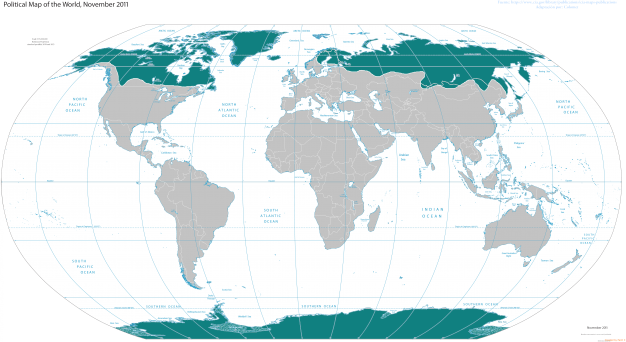Cold zone
Characteristics
- Area
- 60° to 90° North and South latitude
- Sun path
- 53° above the horizon (polar day) to under the horizon (polar night)
- Average temperature
- -47 to 0°C
- Minimal temperature
- -89°C (Antarctica)
- Maximal temperature
- +25°C (Tundra)
- Radiation
- Negative
- Daylength
- 0 to 24 hours (polar night respectively polar day)
- Precipitation
- Variable, mostly in the form of snow
- Climate
- Ice climate (average temperature of the warmest month below 0°C), and tundra climate (average temperature of the warmest month between 0 und 10°C)
- Vegetation
- Polar area: scarce
Tundra: moss, lichens, grass, boreal forest with conifer wood
- Polar area: scarce
- Properties
- Hostile to life, polar lights
The polar regions are the coldest regions on Earth, situated between the poles and the respective polar circles. They are
also called "eternal ice". The northern polar circle includes the Arctic, which includes the northern Polar sea. The
southern polar circle includes the Antarctic region, mainly consisting of the Antarctica continent.
The
special attributes of the polar regions are the climate with much snow and ice, as well as the polar day with the midnight Sun,
which lasts almost half a year at the poles, the polar night, but also the polar lights.
Some areas in the
polar circle have substantially warmer climate; in Norway, the west coast is warmed by the Gulf Stream and has a
yearly average temperature of 4-6°C which is 5-15°C higher than that of comparable places on 60 to 65°N latitude in
other parts of the polar region.
Places
Trondheim, Norway
(63.42°N / 10.42°E, 77 m asl)
Located in Western Norway, close to the North Sea.
Murmansk, Russia
(68.97°N / 33.08°E, 29 m asl)
Located in northern Russia, close to the Arctic Sea.
Yakutsk, Siberia
(62.03°N / 129.73°E, 126 m asl)
Located in continental Siberia, in the polar permafrost area.
Life in the extreme
Arctic - Longyearbyen in example
Longyearbyen is on the Svalbard island with more than 2140 inhabitants (as of 2015) and is one
of the northernmost cities of the world. The yearly average temperature is around -6°C.
Longyearbyen was
founded to extract coal from the mountains of Svalbard and ship it to Europe. Today, Longyearbyen is also a tourism
destination.
In Longyearbyen it is possible to see - depending on the season - the polar day (daylong light) or the polar night (darkness)
for several months per year. Other attractions are the polar lights during the winter, as well as watching the polar
fauna such a icebears, seals, wales etc.
The current daylength and weather conditions are shown on the
meteogram on the right.




